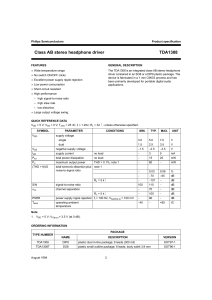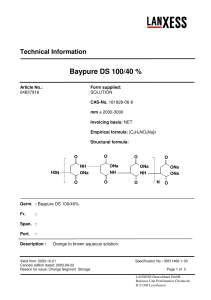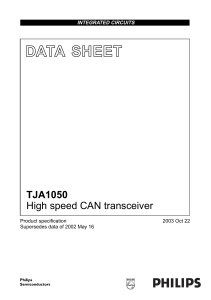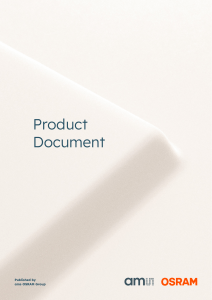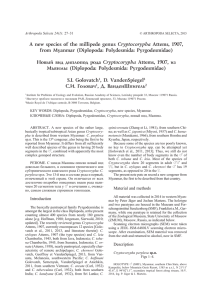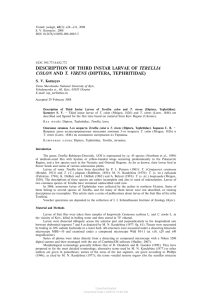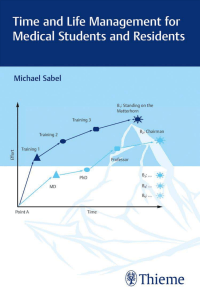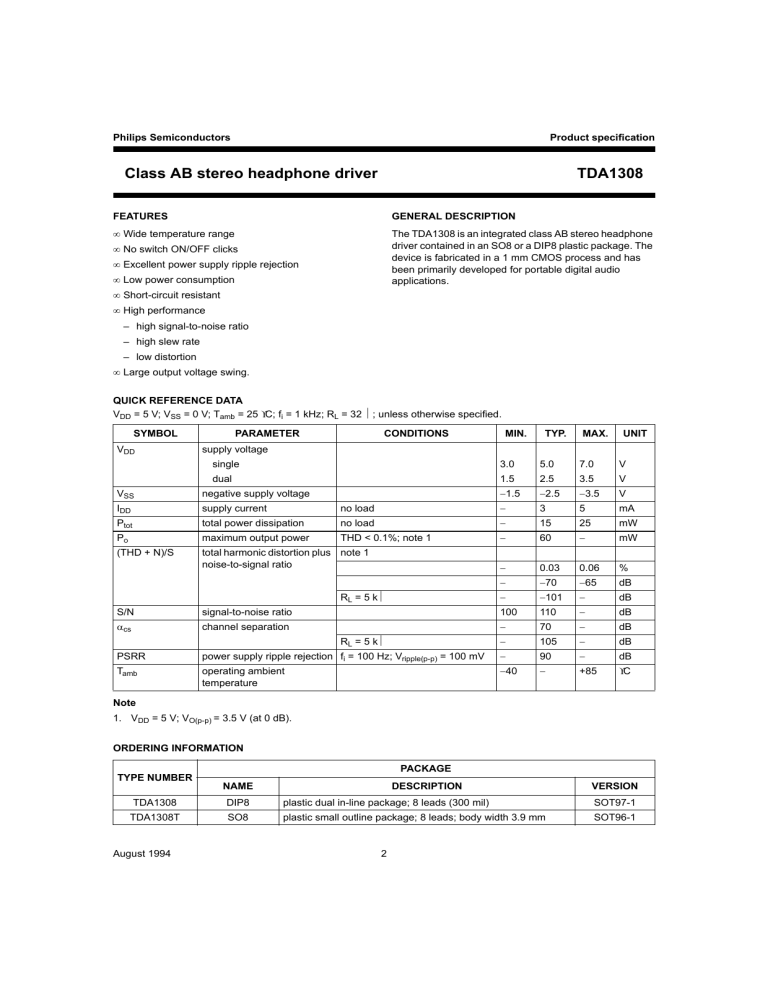
Philips Semiconductors Product specification Class AB stereo headphone driver TDA1308 FEATURES GENERAL DESCRIPTION • Wide temperature range The TDA1308 is an integrated class AB stereo headphone driver contained in an SO8 or a DIP8 plastic package. The device is fabricated in a 1 mm CMOS process and has been primarily developed for portable digital audio applications. • No switch ON/OFF clicks • Excellent power supply ripple rejection • Low power consumption • Short-circuit resistant • High performance – high signal-to-noise ratio – high slew rate – low distortion • Large output voltage swing. QUICK REFERENCE DATA VDD = 5 V; VSS = 0 V; Tamb = 25 °C; fi = 1 kHz; RL = 32 Ω; unless otherwise specified. SYMBOL VDD PARAMETER CONDITIONS MIN. TYP. MAX. UNIT supply voltage single dual 3.0 5.0 7.0 V 1.5 2.5 3.5 V −1.5 −2.5 −3.5 V no load − 3 5 mA total power dissipation no load − 15 25 mW Po maximum output power THD < 0.1%; note 1 − 60 − mW (THD + N)/S total harmonic distortion plus note 1 noise-to-signal ratio − 0.03 0.06 % − −70 −65 dB dB VSS negative supply voltage IDD supply current Ptot − −101 − S/N signal-to-noise ratio 100 110 − dB αcs channel separation − 70 − dB − 105 − dB PSRR power supply ripple rejection fi = 100 Hz; Vripple(p-p) = 100 mV − 90 − dB Tamb operating ambient temperature −40 − +85 °C RL = 5 kΩ RL = 5 kΩ Note 1. VDD = 5 V; VO(p-p) = 3.5 V (at 0 dB). ORDERING INFORMATION PACKAGE TYPE NUMBER NAME DESCRIPTION VERSION TDA1308 DIP8 plastic dual in-line package; 8 leads (300 mil) SOT97-1 TDA1308T SO8 plastic small outline package; 8 leads; body width 3.9 mm SOT96-1 August 1994 2 Philips Semiconductors Product specification Class AB stereo headphone driver TDA1308 BLOCK DIAGRAM Fig.1 Block diagram. PINNING SYMBOL OUTA PIN 1 DESCRIPTION output A INA(neg) 2 inverting input A INA(pos) 3 non-inverting input A VSS 4 negative supply INB(pos) 5 non-inverting input B INB(neg) 6 inverting input B OUTB 7 output B VDD 8 positive supply Fig.2 Pin configuration. August 1994 3 Philips Semiconductors Product specification TDA1308 Fig.3 Equivalent schematic diagram. Class AB stereo headphone driver August 1994 4 Philips Semiconductors Product specification Class AB stereo headphone driver TDA1308 LIMITING VALUES In accordance with the Absolute Maximum Rating System (IEC134). SYMBOL PARAMETER VDD supply voltage tSC(O) output short-circuit duration Tstg storage temperature Tamb operating ambient temperature Vesd electrostatic discharge CONDITIONS Tamb = 25 °C; Ptot = 1 W MIN. MAX. UNIT 0 8.0 V 20 − s −65 +150 °C −40 +85 °C note 1 −2000 +2000 V note 2 −200 +200 V Notes 1. Human body model: C = 100 pF; R = 1500 Ω; 3 pulses positive plus 3 pulses negative. 2. Machine model: C = 200 pF: L = 0.5 mH: R = 0 Ω; 3 pulses positive plus 3 pulses negative. THERMAL CHARACTERISTICS SYMBOL Rth j-a PARAMETER VALUE UNIT DIP8 109 K/W SO8 210 K/W thermal resistance from junction to ambient in free air QUALITY SPECIFICATION In accordance with “UZW-BO/FQ-0601”. The numbers of the quality specification can be found in the “Quality Reference Handbook”. The handbook can be ordered using the code 9398 510 63011. August 1994 5 Philips Semiconductors Product specification Class AB stereo headphone driver TDA1308 CHARACTERISTICS VDD = 5 V; VSS = 0 V; Tamb = 25 °C; fi = 1 kHz; RL = 32 Ω; unless otherwise specified. SYMBOL PARAMETER CONDITIONS MIN. TYP. MAX. UNIT Supplies VDD supply voltage single 3.0 5.0 7.0 V dual 1.5 2.5 3.5 V −1.5 −2.5 −3.5 V VSS negative supply voltage IDD supply current no load − 3 5 mA Ptot total power dissipation no load − 15 25 mW DC characteristics VI(os) input offset voltage − 10 − mV Ibias input bias current − 10 − pA VCM common mode voltage 0 − 3.5 V Gv open-loop voltage gain RL = 5 kΩ − 70 − dB IO maximum output current (THD + N)/S < 0.1% − 60 − mA RO output resistance VO output voltage swing PSRR power supply rejection ratio αcs channel separation − 0.25 − Ω note 1 0.75 − 4.25 V V RL = 16 Ω; note 1 1.5 − 3.5 RL = 5 kΩ; note 1 0.1 − 4.9 V fi = 100 Hz; Vripple(p-p) = 100 mV − 90 − dB − 70 − dB − 105 − dB − − 200 pF RL = 5 kΩ CL load capacitance AC characteristics (THD + N)/S total harmonic distortion plus note 2 noise-to-signal ratio note 2; RL = 5 kΩ − −70 −65 dB − 0.03 0.06 % − −101 − dB − 0.0009 − % 100 110 − dB S/N signal-to-noise ratio fG unity gain frequency open-loop; RL = 5 kΩ − 5.5 − MHz Po maximum output power (THD + N)/S < 0.1% − 60 − mW Ci input capacitance − 3 − pF SR slew rate unity gain inverting − 5 − V/µs B power bandwidth unity gain inverting − 20 − kHz Notes 1. Values are proportional to VDD; (THD + N)/S < 0.1%. 2. VDD = 5.0 V; VO(p-p) = 3.5 V (at 0 dB). August 1994 6 Philips Semiconductors Product specification Class AB stereo headphone driver TDA1308 TEST AND APPLICATION INFORMATION Fig.4 Measurement circuit for inverting application. Fig.5 Example of application with TDA1545A (stereo continuous calibration DAC). August 1994 7 Philips Semiconductors Product specification Class AB stereo headphone driver Fig.6 Open-loop gain as a function of input frequency. Fig.8 Output power as a function of supply voltage. August 1994 TDA1308 Fig.7 8 Crosstalk as a function of input frequency. Philips Semiconductors Product specification Class AB stereo headphone driver TDA1308 Fig.9 Total harmonic distortion plus noise-to-signal ratio as a function of input frequency. Fig.10 Total harmonic distortion plus noise-to-signal ratio as a function of output voltage level. August 1994 9 Philips Semiconductors Product specification Class AB stereo headphone driver TDA1308 PACKAGE OUTLINES 8.25 7.80 9.8 9.2 seating plane handbook, full pagewidth 3.2 max 4.2 max 0.51 min 3.60 3.05 2.54 (3x) 1.15 max 0.53 max 0.254 M 7.62 1.73 max 8 0.38 max 10.0 8.3 5 6.48 6.20 1 4 Dimensions in mm. Fig.11 Plastic dual in-line package; 8 leads (300 mil); DIP8; SOT97-1. August 1994 10 MSA252 - 1 Philips Semiconductors Product specification Class AB stereo headphone driver TDA1308 4.0 3.8 5.0 4.8 handbook, full pagewidth S A 6.2 5.8 0.1 S 0.7 0.3 5 8 0.7 0.6 1.45 1.25 1 4 1.0 0.5 0.25 0.10 pin 1 index detail A 1.27 0.49 0.36 1.75 1.35 0.25 0.19 0 to 8 o MBC180 - 1 0.25 M (8x) Dimensions in mm. Fig.12 Plastic small outline package; 8 leads; body width 3.9 mm. (SO8; SOT96-1). August 1994 11 Philips Semiconductors Product specification Class AB stereo headphone driver TDA1308 SOLDERING BY SOLDER PASTE REFLOW Plastic dual in-line packages Reflow soldering requires the solder paste (a suspension of fine solder particles, flux and binding agent) to be applied to the substrate by screen printing, stencilling or pressure-syringe dispensing before device placement. BY DIP OR WAVE The maximum permissible temperature of the solder is 260 °C; this temperature must not be in contact with the joint for more than 5 s. The total contact time of successive solder waves must not exceed 5 s. Several techniques exist for reflowing; for example, thermal conduction by heated belt, infrared, and vapour-phase reflow. Dwell times vary between 50 and 300 s according to method. Typical reflow temperatures range from 215 to 250 °C. The device may be mounted up to the seating plane, but the temperature of the plastic body must not exceed the specified storage maximum. If the printed-circuit board has been pre-heated, forced cooling may be necessary immediately after soldering to keep the temperature within the permissible limit. Preheating is necessary to dry the paste and evaporate the binding agent. Preheating duration: 45 min at 45 °C. REPAIRING SOLDERED JOINTS (BY HAND-HELD SOLDERING IRON OR PULSE-HEATED SOLDER TOOL) REPAIRING SOLDERED JOINTS Fix the component by first soldering two, diagonally opposite, end pins. Apply the heating tool to the flat part of the pin only. Contact time must be limited to 10 s at up to 300 °C. When using proper tools, all other pins can be soldered in one operation within 2 to 5 s at between 270 and 320 °C. (Pulse-heated soldering is not recommended for SO packages.) Apply the soldering iron below the seating plane (or not more than 2 mm above it). If its temperature is below 300 °C, it must not be in contact for more than 10 s; if between 300 and 400 °C, for not more than 5 s. Plastic small outline packages BY WAVE For pulse-heated solder tool (resistance) soldering of VSO packages, solder is applied to the substrate by dipping or by an extra thick tin/lead plating before package placement. During placement and before soldering, the component must be fixed with a droplet of adhesive. After curing the adhesive, the component can be soldered. The adhesive can be applied by screen printing, pin transfer or syringe dispensing. Maximum permissible solder temperature is 260 °C, and maximum duration of package immersion in solder bath is 10 s, if allowed to cool to less than 150 °C within 6 s. Typical dwell time is 4 s at 250 °C. A modified wave soldering technique is recommended using two solder waves (dual-wave), in which a turbulent wave with high upward pressure is followed by a smooth laminar wave. Using a mildly-activated flux eliminates the need for removal of corrosive residues in most applications. August 1994 12 Philips Semiconductors Product specification Class AB stereo headphone driver TDA1308 DEFINITIONS Data sheet status Objective specification This data sheet contains target or goal specifications for product development. Preliminary specification This data sheet contains preliminary data; supplementary data may be published later. Product specification This data sheet contains final product specifications. Limiting values Limiting values given are in accordance with the Absolute Maximum Rating System (IEC 134). Stress above one or more of the limiting values may cause permanent damage to the device. These are stress ratings only and operation of the device at these or at any other conditions above those given in the Characteristics sections of the specification is not implied. Exposure to limiting values for extended periods may affect device reliability. Application information Where application information is given, it is advisory and does not form part of the specification. LIFE SUPPORT APPLICATIONS These products are not designed for use in life support appliances, devices, or systems where malfunction of these products can reasonably be expected to result in personal injury. Philips customers using or selling these products for use in such applications do so at their own risk and agree to fully indemnify Philips for any damages resulting from such improper use or sale. August 1994 13
